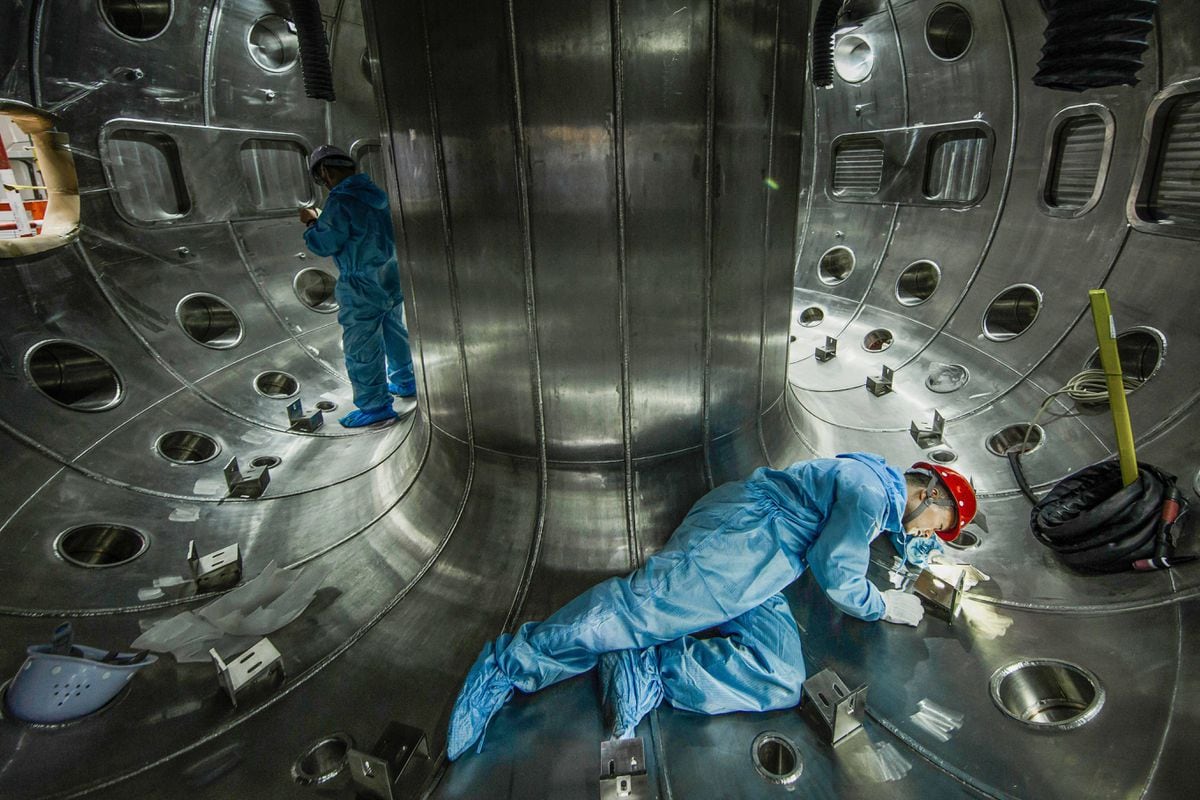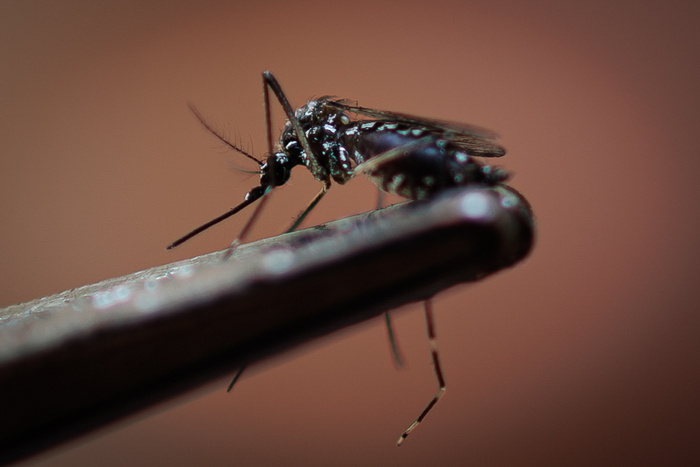With a new procedure, medical protective masks can be disinfected in half an hour and then used again. A researcher explains how it works.
Freising - The virus is adamant. The epidemic claims new lives every day. The health system is hopelessly overwhelmed. Thousands die. The world is shocked. Ebola, which broke out in West Africa in 2014, has also stirred up many people in other parts of the world. At the Fraunhofer IVV, the scenes from that time also left a lasting impression.
Ebola became the driving force for the institute in Freising to research new ways of disinfection in order to better counter upcoming pandemics. In several years of scientific work, a “dry” disinfection process using plasma has been designed. It is possible that the technology that is currently in the test phase will still be used in the fight against Corona.
Dealing with hazardous substances is a problem with chemical processes
Disinfection and sterilization are part of the everyday business of Fraunhofer IVV. "Such processes are common in the packaging and food industry to make products last longer - be it that the packaging is sterilized or the product itself is sterilized," explains Peter Muranyi (43), business area manager for the food sector at the Fraunhofer IVV. A well-known example is UHT milk. "It remains so stable at room temperature because the product and packaging are sterilized and brought together under sterile conditions."
Has researched the new process for years: Dr. Peter Muranyi from Fraunhofer IVV in Freising.
© Fraunhofer IVV
A chemical process is used to fill UHT milk, explains the food technologist. "Films are wetted with hydrogen peroxide and then treated with heat." However, the disadvantage of chemical processes is the handling with hazardous substances, and that residues can remain in the packaging if handled improperly.
The plasma process is therefore one of several alternatives to physical surface disinfection - in addition to the use of UV sources, for example. "At Fraunhofer IVV, we have been dealing with the use of plasma technology for the sterilization of surfaces for many years," reports Muranyi. Since 2016, the institute has been working on mastering civil security challenges with this know-how.
The know-how of Fraunhofer IVV benefits civil protection
"Our scientists are researching the highest possible level of safety for food and products," emphasizes director Andrea Büttner. "We always focus on protecting people and the environment." Safe disinfection processes would therefore not only have to be developed to improve the shelf life of food, but would also have the potential to be transferred to other fields of action. "We see it as our task to open up these technological possibilities."
As part of a tender by the Federal Ministry of Education and Research, the Fraunhofer IVV was awarded the project "MoPlasDekon". "That was at the time of the Ebola pandemic in Africa," reports the 43-year-old. In order to protect aid workers from infection with infectious agents and to minimize the risk of further spread of diseases, effective disinfection methods were required for use in epidemic areas. "Chemicals, such as peracetic acid, are currently used to decontaminate people in protective suits or rooms," reports Muranyi. This not only has the disadvantage of problematic handling of hazardous substances. "It is also difficult to ensure that surfaces are treated evenly."
50 medical protective masks can be prepared in this chamber at the same time.
© Plasmatreat
For example, emergency personnel are usually decontaminated before taking off their protective suits. They are usually scrubbed with brushes - using chemicals and water. "Since suits often wrinkle, it is difficult to apply the disinfectant everywhere," emphasizes Muranyi. At the same time, care must always be taken to collect the chemicals so that they do not seep into the ground. And the time factor also plays an important role. “Sometimes formaldehyde for room disinfection has to work for several hours. In pandemic times, however, it is important that vehicles, protective equipment or rooms are reprocessed much faster. "
Plasma processes not only light up TV sets, they also stop viruses
In order to rule out these negative factors in the event of a disaster, the IVV, together with the industrial partners Plasmatreat and mut, developed the concept for mobile plasma technology for "dry" decontamination. "The process is based on a plasma discharge at atmospheric pressure," explains Muranyi. A plasma is a gaseous state with a certain proportion of free charge carriers: electrons and ions, which are created when the energy is supplied as a result of collision processes. "Technically generated gas plasmas are used industrially to change surface properties, for example when gluing plastic parts in the automotive industry or in the manufacture of semiconductors," reports Muranyi. But gas discharges are also used in television sets or lamps to generate plasmas and thereby visible light.
Depending on the process gases used, working pressure and performance, different reaction products with a microbicidal effect are created - for example high-energy UV radiation, chemically reactive radicals and accelerated charge carriers. Through the combination and synergy effects of the plasma-specific mechanisms of action, bacteria and viruses can also be efficiently inactivated.
Robust, handy, mobile, easy to use: actors from science, industry and civil protection present the device, with which disinfection in plague areas is flexibly possible.
© Plasmatreat
In the developed plasma system, reactive oxygen and nitrogen species are formed using ambient air and water vapor. "The gaseous state enables the treatment of rooms and the objects inside them in a short time," says Muranyi. "The" dry "disinfection with plasma does not pose the problem of having to transport disinfectants and dispose of chemicals. The plasma-activated water vapor dilutes in the air and can be collected via filters or introduced into water. This way, a disinfectant can be produced on site. "
The technology is designed for use in plague areas
The project was completed in August 2019. The process is currently in the test phase. There is already a first demonstrator from Plasmatreat that can disinfect smaller rooms. It essentially consists of a compact generator and a newly designed plasma nozzle, which is connected to the generator and enables flexible use. The disinfection process is carried out with the help of a gas sensor from mut. controlled, which measures when the corresponding room is sufficiently flooded with plasma, and which also indicates when the concentration has dissolved so that the room can be entered again.
"The plasma system was developed in close cooperation with actors from the rescue and civil protection sectors," reports Muranyi. "This way we ensured that many practical aspects were taken into account." The device is light and compact to transport. It is so robust that it can function under adverse conditions, such as extreme heat or cold. In the event that neither an electrical network nor an emergency power generator is available in the area of use, it also runs on battery power. In addition, it can be operated by emergency personnel in protective suits with simple button presses.
Medical masks can be prepared using plasma disinfection within a few minutes. The picture shows a test stand of the BRK, in which the developed plasma system is used.
© Plasmatreat
The technology could also provide valuable help in the current corona pandemic. For example, the remaining bottlenecks in the supply of medical protective equipment could be remedied. "On the initiative of the BRK, a pilot stand for the processing of protective equipment was set up together with the company Plasmatreat, in which the plasma system is connected to a cabinet," explains Muranyi. In this, for example, protective and respiratory masks can be disinfected in 30 minutes, and thus processed up to 2000 pieces per day. "The test phase is promising," reports Muranyi. “The process is currently being tested against Corona. However, we still have to gain knowledge about material compatibility in order to be able to determine how often the masks can be treated before they can no longer be used. ”
The procedure is particularly relevant for clinics, medical practices and retirement homes
The technology is to be developed and approved in a timely manner for use in larger rooms. Since the virus can be transmitted via droplets in the air or through contaminated surfaces, rooms with a high volume of sick people are particularly relevant, ”says Muranyi. These can be ambulances, clinics, doctor's rooms or retirement homes. “But the process is also interesting for the public sector, such as local transport and supermarkets. Here the mobile plasma system could make a contribution to room and air disinfection and thus the interruption of infection chains. "
Read also: This is how the Moosach is opened: Freisings Obere Hauptstraße becomes a meeting center. Zolling's headmaster speaks plainly: Schools face insoluble problems.









